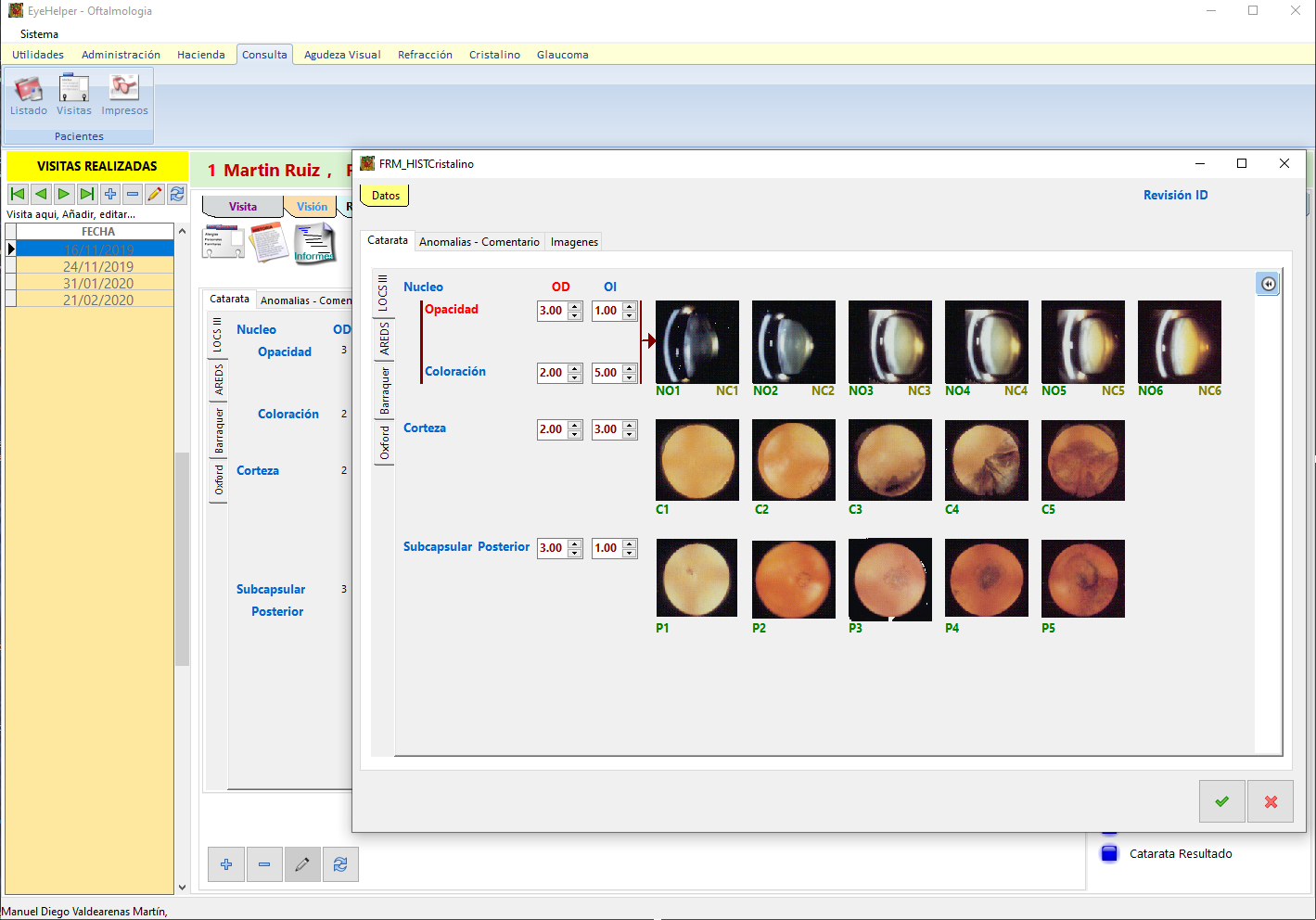This program is designed to carry out computer control of an Ophthalmology consultation in all its aspects: administrative, documentary and medical. It also has different solutions to complex calculation problems in ophthalmology.
It has the following characteristics:
- Version 1.0
- Available for Windows in 32-bit and 64-bit environments.
- Using the Sqlite3 database engine.
- Divided into 4 databases with different purposes: Administration, Clinical History, Material and Finance.
- There is no limitation on the Number of Records in the databases, they meet the specifications of Sqlite3 and the operating system.
- The databases are NOT Encrypted.
- Protected by username and password.
- Only one instance of the program can run on a computer.
- The program must be able to save data to the hard drive. Given Microsoft's policy, it must be run as ADMINISTRATOR.
- Modules:
1. Administration.
It is divided into 4 sections that allow:
- Management of basic databases such as Doctors, cities, provinces, types of patients and scales.
- Management of all the necessary documents: letterheads, glasses prescription, treatments, informed consents, surgical forms ... with the possibility of creating, storing and using personalized forms.
- Use of the necessary elements for the management of treatments: database of medicines, guidelines and personalized treatments available with a single click.
- Contact lens control.
- Laboratory management: delegate, address, telephone ...
2. Medical Consultation.
It has the following characteristics:
- Patient Management: List with search by history number, surname + name and telephone number.
- Possibility of filtering the patient database by any field and / or condition.
- Direct printing of forms with patient data.
- Visits management from the administrative point of view in the same patient file with the possibility of issuing invoices.
- Comprehensive management of the medical history, with 2 possibilities of use: as a word processor or through available forms for the common facets of ophthalmology and for much more specific subspecialties. Only those that are needed can be used. There are indicators to know at all times in which sections data have been entered.
- Comprehensive management of surgical activity: documentary, biometric calculations, treatments ...
- Management of clinical reports.
- The most common ophthalmology fatigue is included.
3. Finance.
- Management of private income, with monthly visualization - quarterly, invoicing and quarterly summary. Possibility of viewing only the queries, operations, special tests and lenses.
- Company income management with monthly, quarterly and billing summary.
- Expense management with monthly, quarterly, annual or company visualization.
- Annual management of the data necessary for the income statement.
4. Visual acuity.
- Theoretical visual acuity according to the refraction of the patient.
- Teller charts, normal mono and binocular visual acuity.
5. Refraction.
- Conversion of the different refraction notation formats: sphero-cylindrical, bicylindrical and vector.
- Southern Refraction.
- Result of the coupling of 2 cylinders.
- Power calculations of a lens according to its distance from the eye: dystometry.
- Analysis of astigmatism induced by corneal surgery.
- Prescription of prisms, sum of prisms and prismatic effect of the decentration of a sphero-cylindrical lens.
- Conversion of cycles / degree and vice versa, calculation of AV snellen according to cycles / cm.
6. Crystalline.
It is focused on the calculation of IOL power.
- IOL constant conversion: A, SF, pACD, ACD and a0.
- Corneal K adjustment WITHOUT corneal surgery: BESSt method.
- IOL power calculation in eyes without previous surgery with the formulas of SRK II, SRK-T, Haigis, Holladay I and Hoffer Q.
- IOL power calculation in case of Refractive Surprise: Piggy-Back according to Gayton, Gills and Shammas formulas or IOL replacement according to SRK, Gayton and Silguero formulas.
- Calculation of the optimized Holladay ELP and the Holladay Refractive formula.
- Calculation of IOL power in patients with previous refractive surgery: adjustment of the K whether the medical history is known (methods of the medical history, Jarade, Sabini and Camellin) or not (methods of the GP contact lens, Maloney, Ferrara, Haigis L and Besst), calculation of IOL power with the double K method (SRK-T, Hoffer Q and Holladay I).
- Calculation of toric IOL power with the formula of Holladay I.
- Intraocular Lens Database: constants, diopter range and IOL characteristics. Data for current IOLs from some manufacturers is included.
7. Glaucoma.
- IOP adjustment according to corneal thickness.
- Chamber angle analysis according to Sheie, Van Herick and OCT AOD 500.
- Analysis of the risk of suffering from glaucoma according to the URGE method.
- Analysis of the risk of suffering from glaucoma according to the OHTS-EGPS method (points and continuous).
8. Configuration.
It allows the adaptation of the program to our needs.
- Language selection.
- Selection of the physical location of the databases on our computer or on the network.
- Backup, restoration, verification or joint deletion.
- Backup, restore, check or delete each database individually.
Contextual help on each form or page.
Available in 4 languages: Spanish, English, Arabic and Simplified Chinese.
Designed to use the keyboard in the essentials. Many actions can be performed with the mouse.
Some screenshots:
- Screen of a patient's medical history.
You can see the visits made, the background file, the rest of the necessary elements.
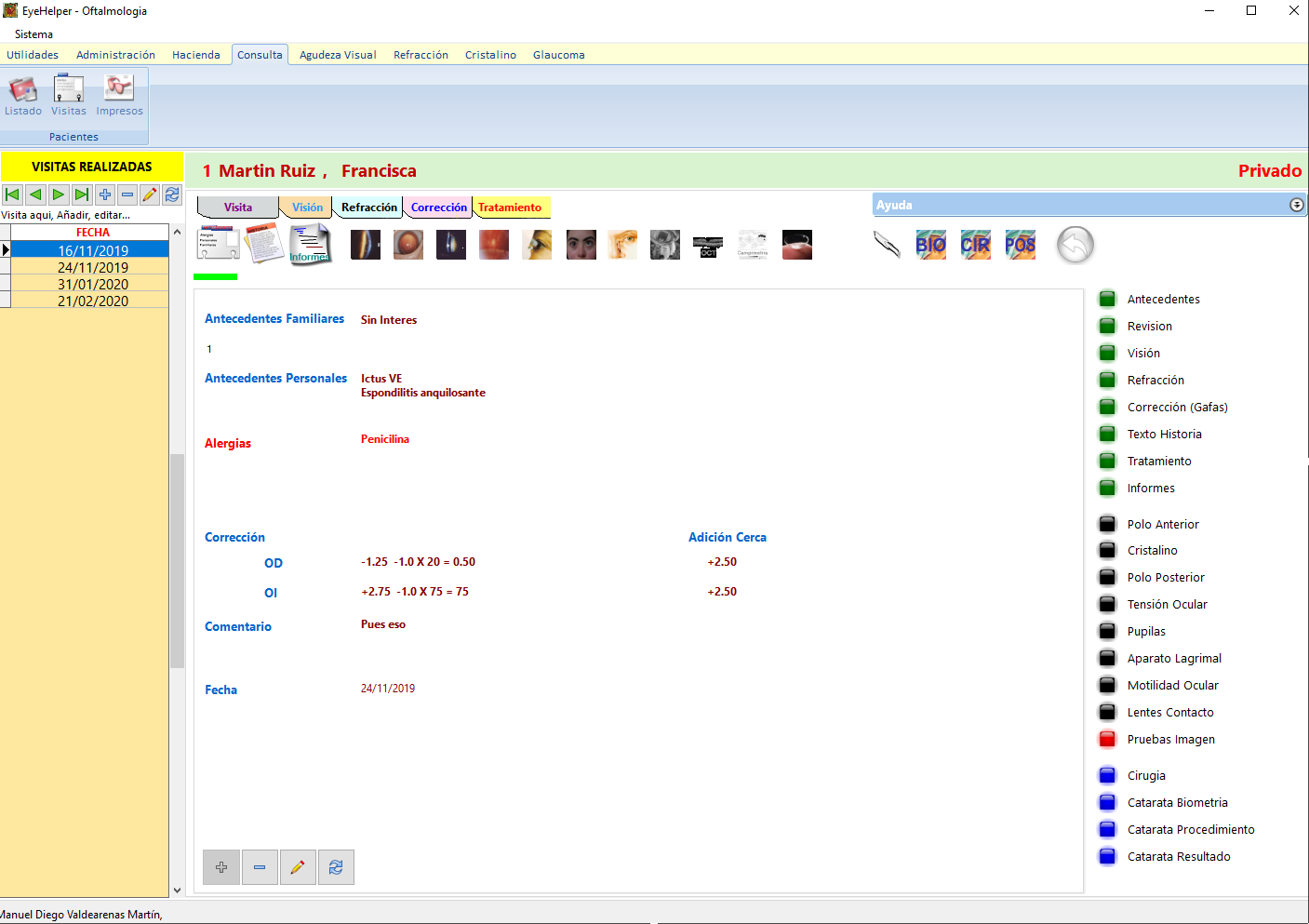
- Screen with the general data for calculating the power of the intraocular IOL in a "usual" cataract.
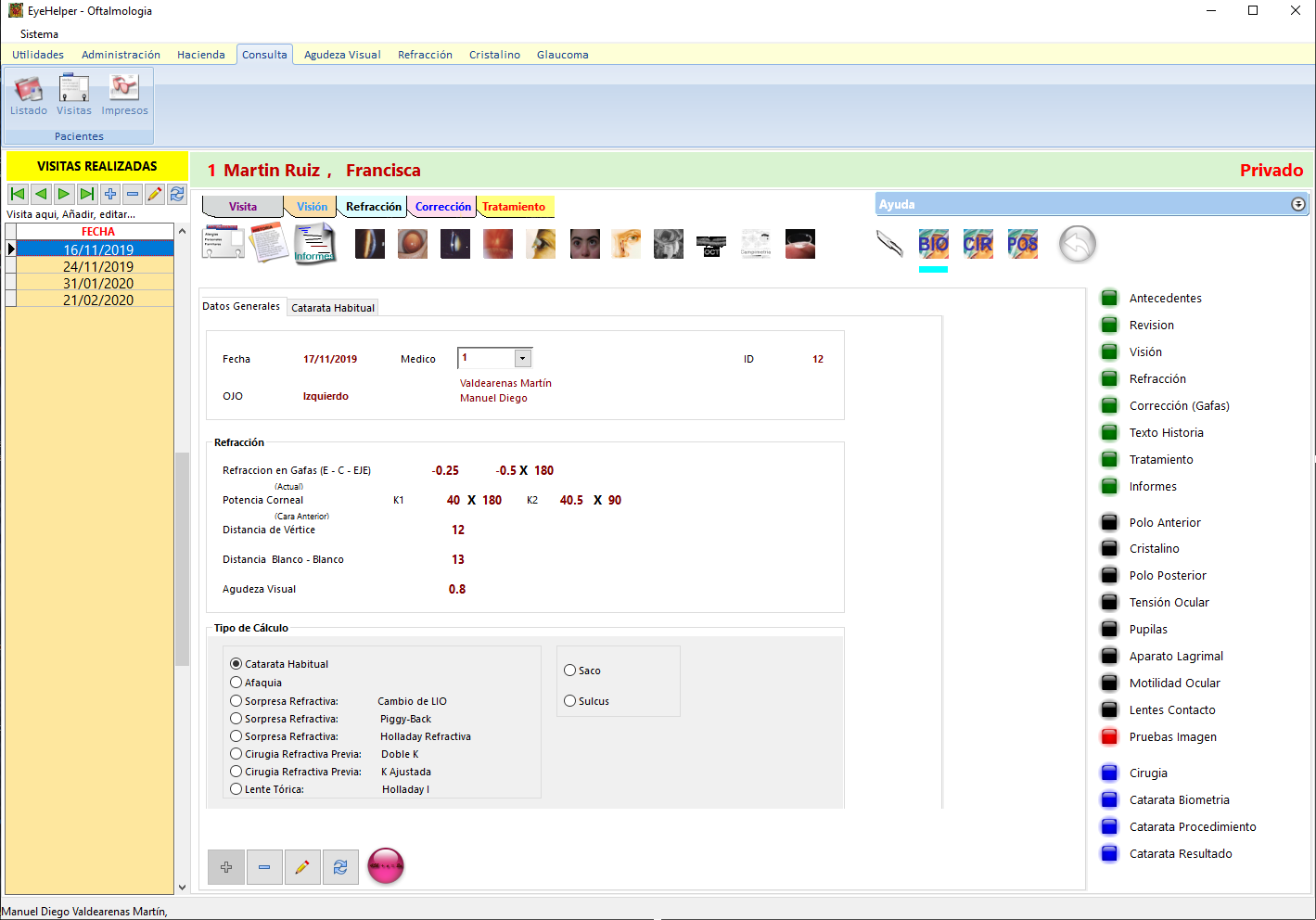
- Screen with the calculation of the powers with the formulas of SRK-T, Holladay I, Haigis and Hoffer-Q.
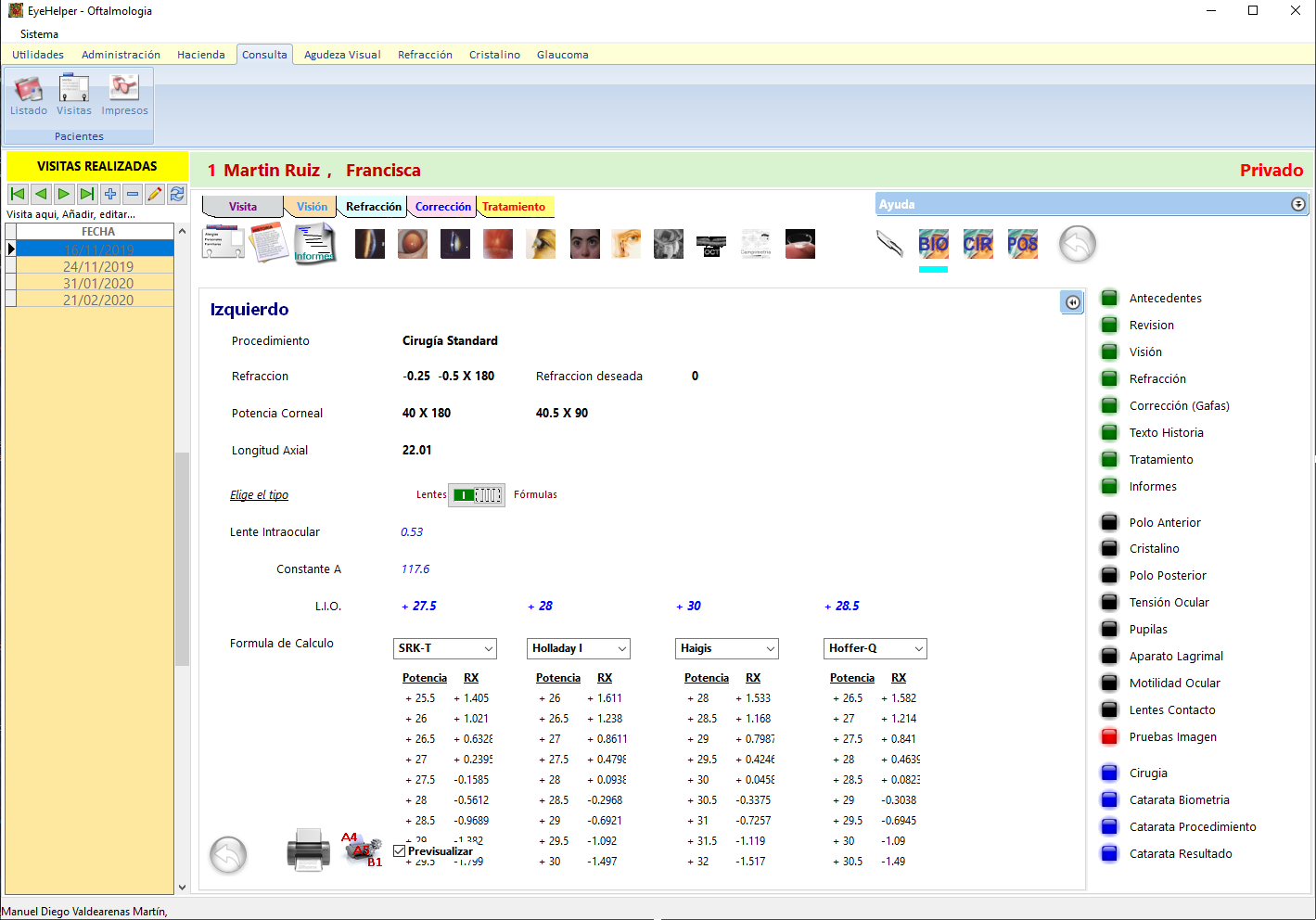
- Screen showing the form for the prescription of optical correction.
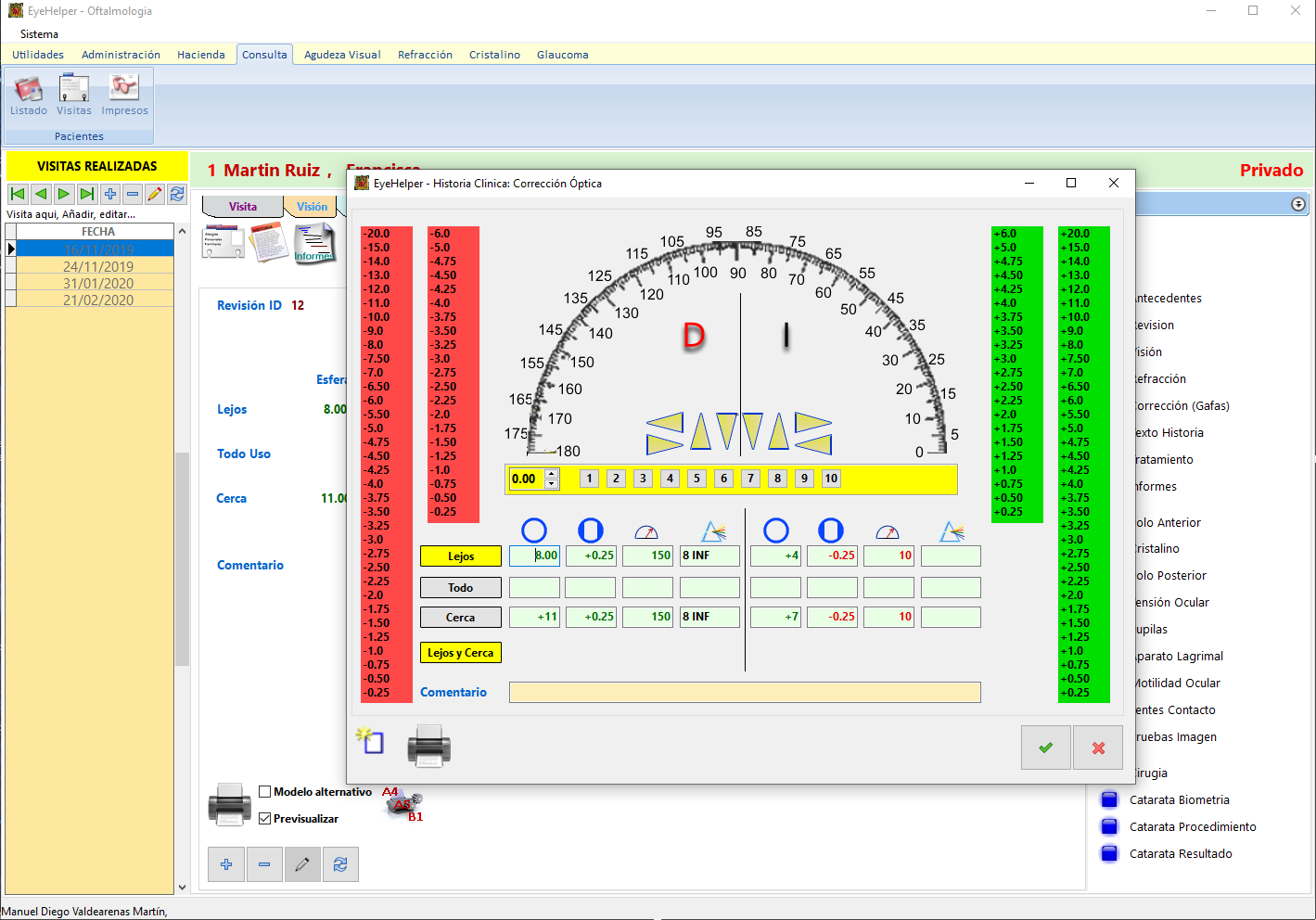
- Screen in which the form for the evaluation of the Lens is observed, LOCS III classification of the 4 available (LOCS III, AREDS, Barraquer and Oxford).
